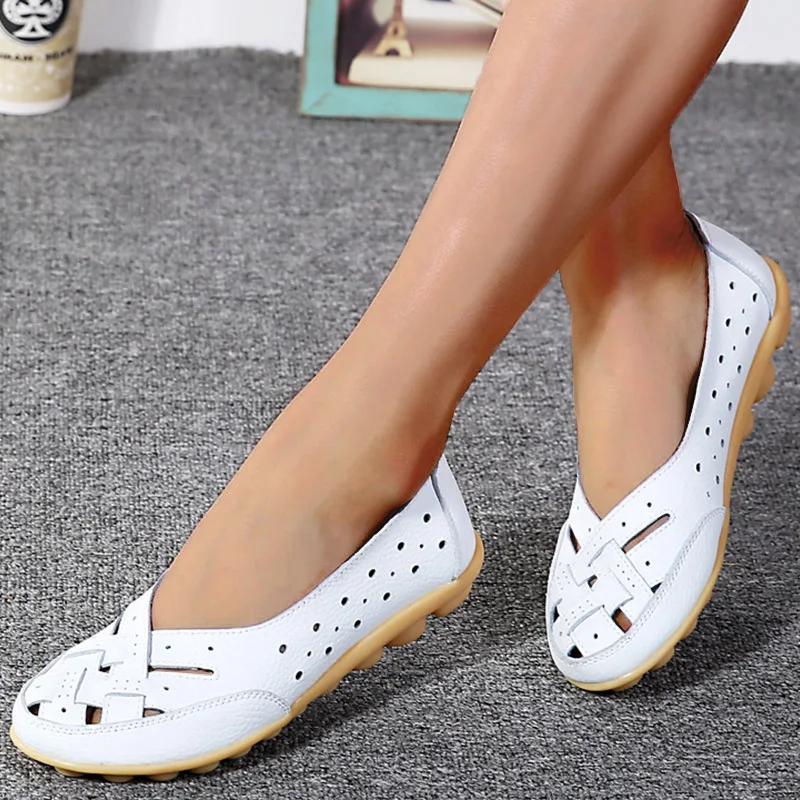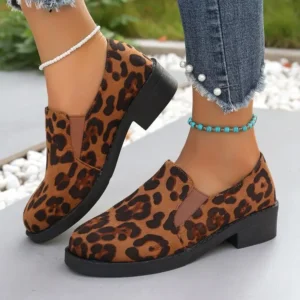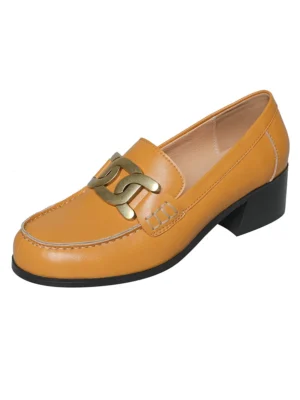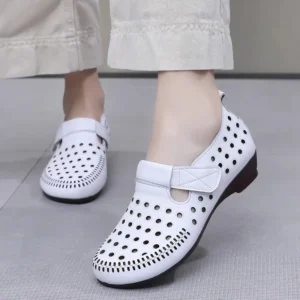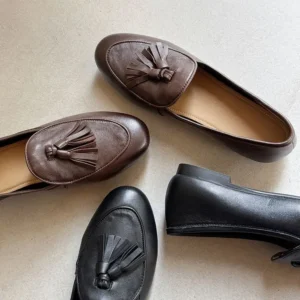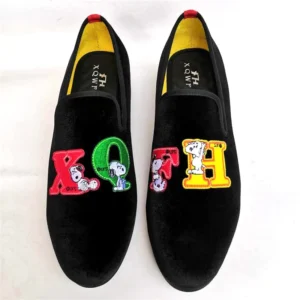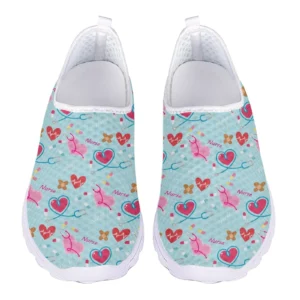Understanding Why Penny Loafers Can Be Uncomfortable
Penny loafers are timeless classics that bring elegance to any outfit, but many wearers struggle with their comfort, especially during the first few weeks. These stylish shoes often come with several common discomfort issues:
- Stiffness: New loafers typically have rigid leather that hasn’t conformed to your feet yet
- Heel rubbing: The back of loafers can rub against your heel, causing painful blisters
- Pressure points: Areas where the leather presses too firmly against your foot
- Lack of arch support: Traditional loafers often have minimal built-in support
The discomfort stems from how penny loafers are constructed. Traditional crafting methods focus on creating a sleek silhouette and durable shoe that maintains its shape, sometimes at the expense of immediate comfort. The leather upper, while beautiful, needs time to soften and mold to your unique foot shape.
Most discomfort occurs in specific areas: the heel counter (back of the shoe), the sides where the leather meets your foot, and across the top of the instep where the penny strap sits. The good news is that with proper techniques, even the stiffest loafers can become some of the most comfortable shoes in your collection.
Understanding comfortable walking loafers and their construction helps explain why the initial discomfort is worth enduring. Quality women’s penny loafers are crafted to last years—sometimes decades—with proper care, and once broken in, they offer unparalleled comfort and versatility.
The Essential Break-In Period: Making New Penny Loafers Comfortable
The break-in period is crucial for transforming stiff loafers into comfortable favorites. This process allows the leather to soften and conform to your unique foot shape, creating a custom fit that feels like it was made just for you.
Here’s a gradual wearing schedule for optimal results:
- First wear: Limit to 1-2 hours around your home
- Second and third wears: Extend to 3-4 hours, preferably indoors
- Fourth and fifth wears: Try 4-6 hours, including short outdoor walks
- Following wears: Gradually increase time until you can wear them comfortably all day
Proven break-in techniques to speed up the process:
- Thick sock method: Wear thick socks with your loafers and apply heat from a hairdryer while flexing your feet
- Shoe stretcher technique: Use an adjustable shoe stretcher overnight, focusing on tight areas
- Strategic bending: Gently flex the sole back and forth at the ball of the foot to increase flexibility
- Professional stretching: Cobblers can stretch specific tight spots without damaging the leather
During the break-in period, you’ll notice the leather gradually becoming softer and more pliable. The insole will start developing slight depressions where your feet naturally rest. These changes are positive signs that your loafers are adapting to your foot shape.
Many people worry about damaging their loafers during break-in, but quality leather is remarkably resilient. The key is applying gentle, consistent pressure rather than forcing dramatic changes all at once. Learning how to wear loafers without hurting feet makes a significant difference in your comfort level during this critical period.
Optimal Fit Solutions: Addressing Specific Comfort Issues
For Too-Tight Loafers
- Apply leather stretching spray to specific tight areas and wear until dry
- Use wooden shoe stretchers with targeted pressure points for problem areas
- Visit a professional cobbler for stretching when home methods aren’t enough
- Focus stretching efforts on the width rather than length for best results
For Too-Loose Loafers
- Add thin leather insoles to take up volume without changing the external appearance
- Use tongue pads to prevent feet from sliding forward
- Try heel grips combined with ball-of-foot cushions to stabilize foot position
- Consider cork insoles that mold to your feet with body heat
For Heel Slippage
- Apply self-adhesive heel grips to the back interior of the loafer
- Use 3/4 length insoles that raise the foot slightly and improve heel fit
- Try heel cups that cradle your heel and prevent upward movement
- Adjust your walking technique by engaging your foot muscles more actively
For Toe Box Discomfort
- Use specialized toe box shoe stretchers with adjustable width plugs
- Apply stretching spray specifically to the toe area before stretching
- Choose comfortable flat loafers with appropriate toe shapes for your foot type
- Use thin toe cap cushions to protect pressure points
The key to solving fit issues is identifying the exact problem area and applying targeted solutions. Sometimes combining multiple approaches—like a heel grip with a thin insole—creates the perfect balance of comfort and fit.
Insoles and Inserts: Adding Support and Cushioning to Penny Loafers
The right insoles can transform your penny loafers from merely acceptable to incredibly comfortable. Since loafers typically have minimal built-in support, adding the right inserts makes a tremendous difference.
Types of insoles suitable for penny loafers:
- Ultra-thin full insoles: Add minimal cushioning without changing fit (1-2mm thick)
- 3/4 length insoles: Support the arch without crowding the toe box
- Full-length contoured insoles: Provide maximum support but require slightly roomier loafers
- Heel cups: Focus support where many people need it most
Material comparison:
– Memory foam: Offers soft cushioning but compresses over time
– Gel inserts: Excellent for shock absorption, especially in ball-of-foot areas
– Cork: Molds to your foot shape and offers natural support
– Leather-covered: Most breathable option that minimizes odor and moisture
Different foot types require different support. If you have flat feet, look for insoles with moderate arch support and cushioning. High arches benefit from deeper heel cups and significant arch support to prevent fatigue.
The challenge with penny loafers is adding comfort without affecting the sleek profile. Look for insoles marketed specifically for dress shoes, as these are designed to provide support without excess bulk. For targeted relief, ball-of-foot cushions or arch supports can address specific discomfort without changing the overall fit.
Understanding proper foot support in flat loafers is essential for all-day comfort, especially if you’re on your feet frequently. The right insole not only improves comfort but can correct minor gait issues and prevent foot fatigue.
The Role of Socks: Optimizing Comfort Through Smart Sock Choices
Your sock choice significantly impacts loafer comfort, affecting everything from fit to blister prevention. The right socks can make even stiff loafers feel immediately more comfortable.
Sock thickness affects fit in important ways:
– Thicker socks can help during break-in by creating gentle pressure on tight spots
– Thin socks allow more room in loafers that fit perfectly
– Medium-weight socks provide cushioning while maintaining fit
Material comparison for blister prevention:
– Merino wool: Natural moisture management, temperature regulation, odor resistance
– Cotton: Soft and breathable but retains moisture
– Synthetic blends: Excellent moisture-wicking but may cause more foot odor
– Silk: Ultra-thin option that reduces friction while remaining elegant
For loafer-specific options, consider:
– No-show loafer socks: Hidden below the shoe line while preventing direct skin contact
– Loafer liners: Ultra-thin socks that provide minimal cushioning but excellent blister protection
– Toe-only half socks: Protect toes while leaving the heel bare for better grip
For the sockless look without discomfort:
– Apply powder or antiperspirant to feet before wearing
– Use washable terry cloth insoles that absorb moisture
– Consider invisible liner socks with silicon heel grips
During break-in, strategic sock use can speed the process. Start with thicker socks to help stretch the leather, then gradually transition to your preferred everyday sock thickness as the loafers become more pliable.
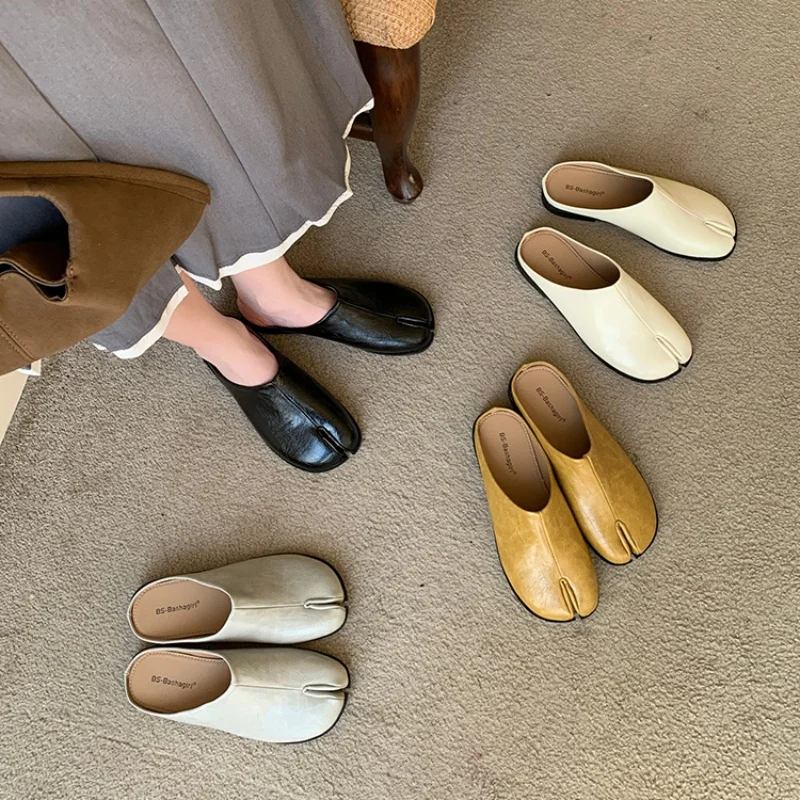
Material Matters: Care Techniques for Maximum Comfort
The materials of your penny loafers significantly impact their comfort potential, and proper care directly enhances how they feel on your feet.
Leather Care for Enhanced Flexibility
- Apply quality leather conditioner every 4-6 weeks to maintain suppleness
- Use leather oil sparingly on extremely stiff areas to accelerate softening
- Allow 24 hours between wearings for leather to rest and regain shape
- Clean with gentle leather cleaner to remove dirt that can make leather stiff
Suede and Nubuck Maintenance
- Use a suede brush regularly to maintain the nap and flexibility
- Apply waterproofing spray to prevent stiffening from water damage
- Clean with specialized suede cleaner that won’t harden the material
- Use a suede eraser for spot cleaning without damaging the soft surface
Patent Leather Considerations
- Apply patent leather cream to prevent cracking at flex points
- Use a soft cloth with specialized patent cleaner to remove buildup
- Store with shoe trees to maintain shape and prevent comfort-affecting creases
- Avoid excessive heat that can cause patent leather to harden
Vegan/Synthetic Materials
- Clean with mild soap and water to prevent material degradation
- Apply synthetic-specific conditioners that maintain flexibility
- Check for separation between materials that can create pressure points
- Use shoe trees to maintain shape, as synthetics can deform more easily than leather
Maintaining pristine leather loafers isn’t just about appearance—it directly impacts comfort. Regular conditioning prevents the leather from drying out and becoming rigid, while proper cleaning removes dirt that can act like sandpaper against your feet.
A consistent care routine extends the comfort lifespan of your loafers. Even the most comfortable pair will eventually become stiff and uncomfortable without proper maintenance. Investing a few minutes each week in care routines can add years of comfortable wear to your favorite pairs.
Blister Prevention Strategies: Protecting Sensitive Areas
Preventing blisters before they start is much easier than dealing with them after they’ve formed. Here’s how to protect vulnerable areas:
- Identify potential hot spots by wearing your loafers for 30 minutes and noting areas that feel warm or irritated
- Apply moleskin preventatively to these areas before prolonged wear
- Use silicone heel protectors on the back of your heels where most blisters form
- Apply anti-friction sticks (similar to clear deodorant) on potential trouble spots
- Consider specialized blister-prevention tape for targeted protection
For maximum effectiveness:
1. Clean and dry the area completely before applying any product
2. Cut moleskin slightly larger than the potential blister area
3. Apply without wrinkling or overlapping edges
4. Replace at first sign of peeling or after significant sweating
If a blister does form:
1. Clean the area gently with mild soap and water
2. Apply an antibiotic ointment if the blister has broken
3. Cover with a specialized blister bandage that creates a cushioned healing environment
4. Switch to different shoes until healing is complete
To prevent recurring problems, track which specific activities or durations cause issues and adjust accordingly. Sometimes simple changes like different leather penny loafers or sock combinations can eliminate persistent blister problems.
Remember that new shoes almost always present higher blister risk, so be especially vigilant during the break-in period and plan shorter wear sessions until you’ve identified and addressed potential problem areas.
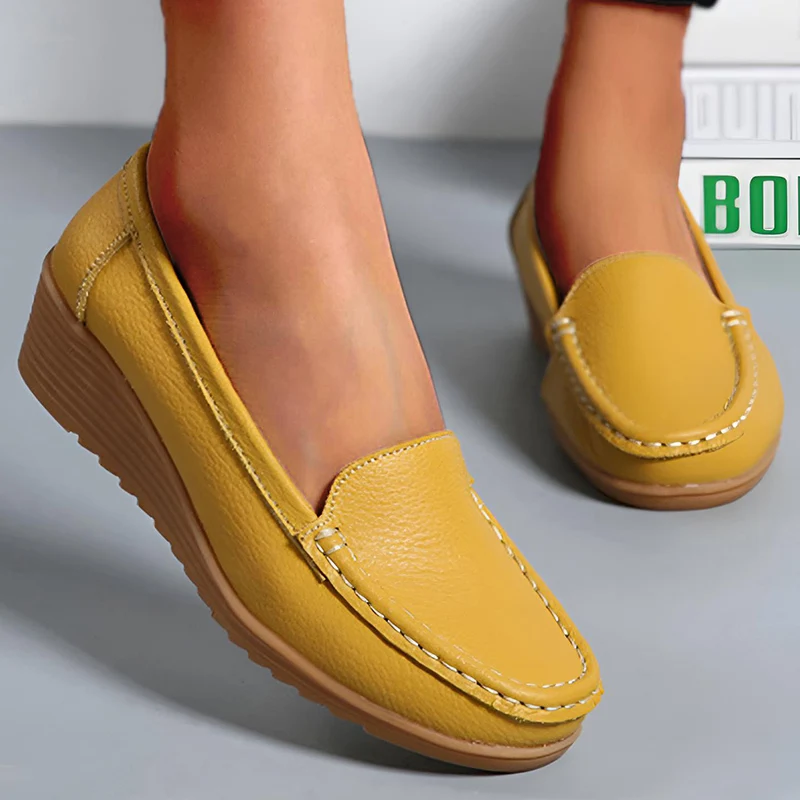
When to Consider Professional Modifications
While many comfort issues can be resolved at home, some situations benefit from professional expertise:
- Complex stretching needs (specific widening of toe box or instep)
- Addition of professional-grade sole cushioning
- Replacement of stiff insoles with cushioned alternatives
- Custom heel modifications for unusual foot shapes
Professional cobbler services for comfort enhancement:
– Precision stretching ($15-30) targeting specific tight areas
– Addition of padded insoles ($25-40) professionally fitted
– Sole additions for shock absorption ($40-70)
– Custom arch support installation ($35-60)
When communicating with your cobbler:
1. Wear the socks you typically pair with your loafers
2. Point out specific discomfort areas rather than just saying “they hurt”
3. Describe when the discomfort occurs (immediately or after hours of wear)
4. Bring any inserts you’ve tried so they understand previous solutions
Professional modifications are particularly valuable for preserving expensive loafers that have comfort issues. A skilled cobbler can often resolve problems without changing the external appearance of your shoes, allowing you to keep the style you love while gaining the comfort you need.
Long-Term Comfort Maintenance: Daily Practices
Maintaining the comfort of your penny loafers requires consistent daily habits:
- Rotate between multiple pairs to allow each at least 24 hours of rest between wears
- Insert cedar shoe trees immediately after removing to absorb moisture and maintain shape
- Wipe down with a soft cloth to remove dust and dirt that can abrade the interior
- Allow to air out completely before storing in closets or shoe bags
- Check for developing wear patterns that might indicate alignment or gait issues
Proper storage significantly impacts comfort:
– Store horizontally rather than stacked to prevent deformation
– Use shoe trees that maintain shape but don’t overstretch
– Keep in moderate temperature and humidity to prevent leather hardening
– Avoid plastic bags that trap moisture and promote stiffening
Watch for these signs that comfort features need refreshing:
– Compressed insoles that no longer provide cushioning
– Visible wear on the heel lining indicating friction
– Hardening of previously supple leather
– Uneven sole wear suggesting alignment issues
Understanding how to maintain comfortable loafers for all-day walking ensures you’ll get maximum wear from your investment. Proper maintenance doesn’t just extend the life of your loafers—it extends the comfort phase of their lifespan.
Women's Comfortable Flat Loafers, Women's Leopard Print Loafers, Women's Low Heel Loafers
$82.50 Select options This product has multiple variants. The options may be chosen on the product pageWomen's Block Heel Loafers, Women's Heeled Penny Loafers, Women's Monk Strap Loafers
$194.04 Select options This product has multiple variants. The options may be chosen on the product pageWomen's Comfortable Flat Loafers, Women's Leather Flat Loafers, Women's Round Toe Flat Loafers
$124.88 Select options This product has multiple variants. The options may be chosen on the product pageWomen's Black Flat Loafers, Women's Black Penny Loafers, Women's Classic Tassel Loafers
$194.28 Select options This product has multiple variants. The options may be chosen on the product pageWomen's Classic Tassel Loafers, Women's Suede Penny Loafers
Price range: $133.16 through $147.56 Select options This product has multiple variants. The options may be chosen on the product pageWomen's Classic Driving Loafers, Women's Classic Penny Loafers, Women's Comfortable Flat Loafers
$75.28 Select options This product has multiple variants. The options may be chosen on the product page
Can You Make Any Penny Loafer Comfortable?
While proper techniques can significantly improve most penny loafers, there are limitations to what modifications can accomplish. Not every loafer can be transformed into an all-day comfort shoe.
Quality indicators that suggest good comfort potential:
– Full leather lining (not partial or synthetic)
– Visible cushioning in the footbed
– Flexibility in the sole when bent
– Smooth interior seams without bulky stitching
Construction elements that resist comfortable modification:
– Extremely stiff leather that doesn’t yield to gentle pressure
– Very pointed toe shapes that compress the toes unnaturally
– Completely flat footbeds with no contour
– Plastic or fiberboard components that don’t mold with wear
Sometimes the wiser choice is replacement rather than modification, especially when:
– The shoe causes pain even after multiple break-in attempts
– Stretching has already caused visible material distortion
– The basic shape fundamentally doesn’t match your foot anatomy
– Modifications would cost more than 40% of the shoe’s value
Finding classic penny loafers that match your foot shape from the beginning is the best approach. While comfort modifications can work wonders, starting with well-designed loafers significantly increases your chances of achieving all-day comfort.
What Makes a Penny Loafer Inherently Comfortable? Features to Look For
When shopping for new penny loafers, these comfort-enhancing features make a significant difference:
- Flexible sole construction that bends at the ball of the foot without resistance
- Memory foam or cork footbeds that mold to your foot’s contours
- Padded heel collars to prevent slipping and rubbing
- Breathable leather lining to manage moisture
- Wider toe boxes that don’t compress your toes
- Lightweight materials that reduce fatigue
- Shock-absorbing sole layers to cushion impact
High-quality construction methods that enhance comfort include:
– Blake stitching that allows for greater sole flexibility
– Bologna construction creating a glove-like fit
– Hand-sewn moccasin techniques for a more forgiving fit
Materials make a significant difference in comfort potential. Full-grain leather molds beautifully to feet over time, while softer leathers like calfskin require less break-in. Understanding how toe shape affects comfort helps you select styles that work with your foot anatomy rather than against it.
Remember that properly sized comfortable loafers should feel snug but never painful from the first try-on. While some break-in is expected, extreme discomfort suggests a fundamental mismatch between the shoe design and your foot.
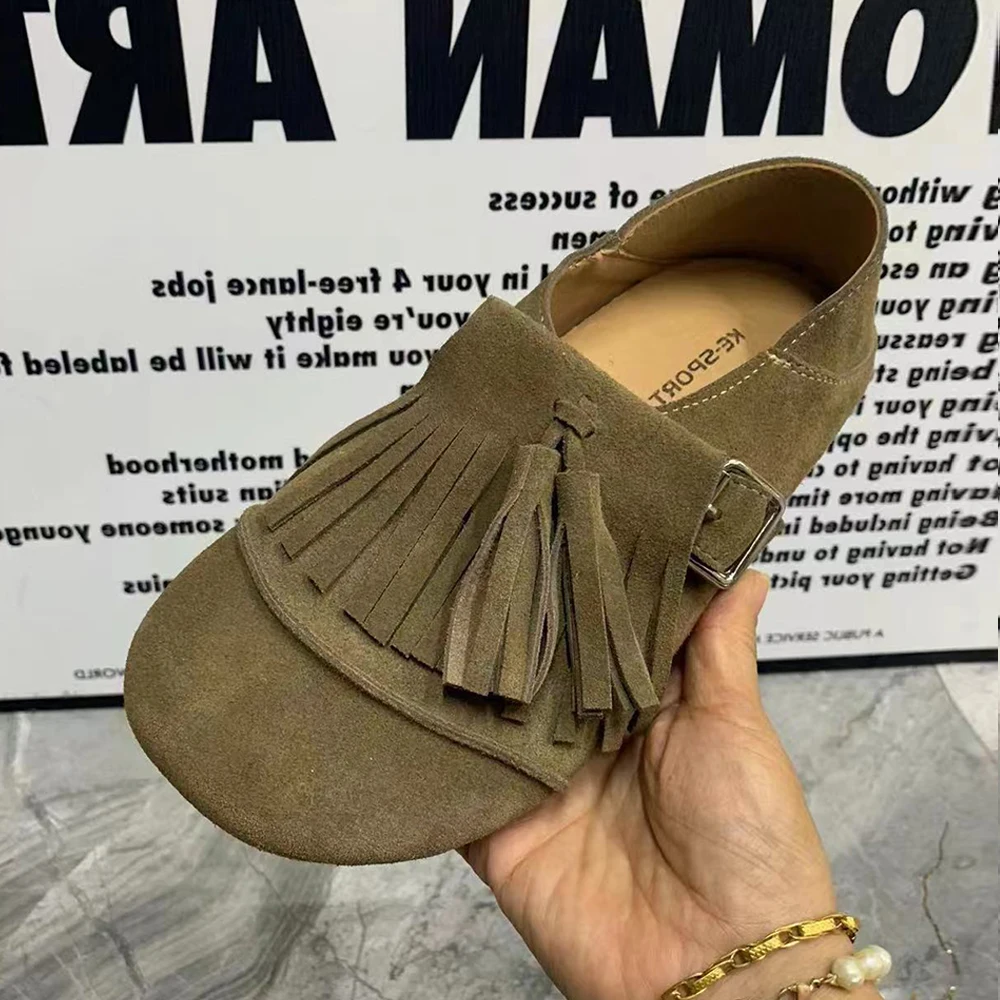
Is Breaking In Penny Loafers Really Necessary?
Yes, breaking in penny loafers is essential—even the highest quality pairs. This isn’t a sign of poor quality but rather a characteristic of good leather footwear. Natural leather needs time to adapt to your unique foot shape, creating a custom fit that mass-produced shoes can’t offer right out of the box.
Many people mistakenly believe that discomfort means they’ve chosen the wrong size. While severe pain does indicate a sizing issue, mild tightness or stiffness is normal during break-in. Quality loafers should feel snug initially, with slight pressure but no sharp pain.
After proper break-in, which typically takes 7-14 days of regular wear, your loafers should feel like they were made specifically for your feet. The leather will have softened, the footbed will show slight impressions where your feet rest, and the initial stiffness will be replaced by supple flexibility.
Some modern loafers feature pre-softened leathers or added cushioning that reduce break-in time, but even these benefit from a gradual introduction period that allows the materials to conform to your unique foot shape.
How Do I Know If My Penny Loafers Are the Right Size?
Proper fit is fundamental to comfort. Check these indicators to confirm your loafers are correctly sized:
✓ Your heel sits securely with minimal slippage when walking
✓ You can wiggle your toes, but they don’t slide forward excessively
✓ The widest part of your foot aligns with the widest part of the shoe
✓ You feel gentle security around the instep, not pinching
✓ Your toes don’t hit the front when walking downhill or stopping suddenly
Common sizing mistakes with penny loafers:
– Buying too small hoping they’ll “stretch out” (they’ll only stretch minimally)
– Selecting based only on length without considering width
– Ignoring instep height, which affects how loafers fit across the top of your foot
– Not accounting for afternoon foot swelling when trying on shoes
To distinguish between size issues and break-in issues, remember that:
– Size problems cause pain immediately and in specific areas
– Break-in discomfort is more general stiffness that improves with each wear
– Correct size may feel snug initially but never causes numbness or sharp pain
– Width issues typically cause side pressure, while length issues affect toes and heel
If you’re between sizes, opt for the larger size and use inserts to fine-tune the fit rather than suffering in too-small loafers.
What If My Feet Are Different Sizes?
Having differently sized feet is remarkably common—about 60% of people have one foot larger than the other. This difference creates unique challenges with penny loafers, which don’t have adjustable closures like laced shoes.
When selecting size for unequally sized feet:
– Always buy for your larger foot to prevent pain and injury
– Use inserts and pads to improve fit on the smaller foot
– Consider removable insoles that can be swapped for different thicknesses
Effective modifications for the smaller foot include:
– Tongue pads to take up volume across the instep
– Heel grips to prevent slippage
– Full-length thin insoles to raise the foot slightly
– Ball-of-foot cushions to prevent forward sliding
For significant size differences (more than one full size), consider:
– Purchasing different sized shoes if the manufacturer offers split-sizing
– Having a cobbler add internal padding to the smaller shoe
– Using specialized adjustable insoles that allow different thicknesses
These modifications ensure both feet experience equal comfort without compromising blood circulation or creating pressure points.
How Do Weather and Seasons Affect Penny Loafer Comfort?
Seasonal changes significantly impact how your penny loafers fit and feel. Understanding these variations helps you maintain comfort year-round.
Summer Adjustments
- Feet typically swell more in hot weather, making loafers feel tighter
- Leather stretches more readily in heat and humidity
- Moisture-wicking socks become essential for comfort
- Consider a slightly roomier summer pair if you experience significant swelling
Winter Considerations
- Cold weather can make leather stiffen temporarily
- Thicker socks may be needed, requiring loafers with more volume
- Indoor heating can cause excessive dryness, requiring more frequent conditioning
- Sudden temperature changes (cold outside, heated indoors) stress leather flexibility
Rainy Season Preparation
- Waterproofing treatments prevent water absorption that leads to stiffness
- Wet leather should be dried slowly with shoe trees to prevent comfort-reducing shrinkage
- Allow 48 hours of drying time with cedar shoe trees after significant exposure
- Consider dedicated rainy-day loafers with water-resistant properties
Maintaining consistent leather conditioning adjusted to seasonal needs ensures your loafers remain comfortable regardless of weather changes. In drier months, condition more frequently; in humid periods, focus more on proper drying between wears.
At Artisan Haul, we understand that true loafer comfort comes from the perfect combination of quality materials, proper fit, and personalized care. By applying these techniques, your favorite penny loafers can provide both timeless style and exceptional comfort for years to come.

